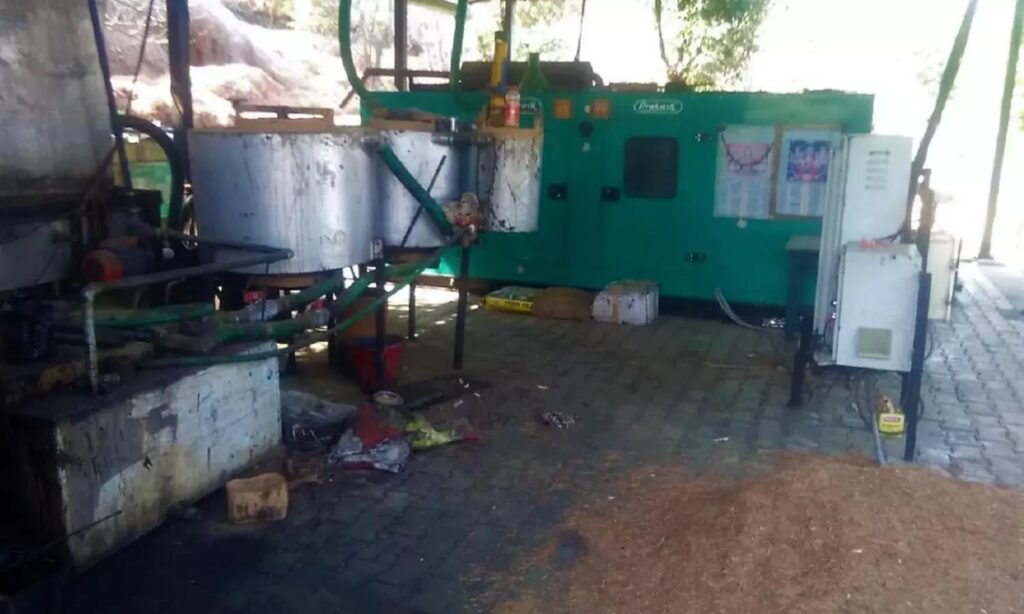Uttarakhand: Why the power generation project from Pirul is not catching up

Rajneesh Jain, a resident of Pithoragarh, Kumaon division of Uttarakhand, generated electricity in Berinag with a 10 kW power plant in the year 2009 from pine leaves i.e. Pirul, found in the forest, and improving his technology, he installed a 25 kW power plant in the year 2017. The plant is not only generating electricity, but also providing employment to the local people, especially women, and also reducing the problem of forest fires in the state. But even after getting encouragement from the state government, his technique has so far failed to catch pace.
Rajneesh Jain, the founder of Avani Bio Energy, says that the electricity generated from this plant has illuminated his home and office when there was a power failure for several days during rains and snowfall. Rajneesh Jain’s initial success and forest fire In the year 2018, the Government of Uttarakhand came up with the Pirul and other biomass policy with the idea of removing Pirul from it.
The policy, made in the year 2018, said, “Uttarakhand is extremely rich in availability of pine leaves in the form of biomass. It is estimated that more than 15 lakh metric tonnes annually in reserve and van panchayat forests (excluding wildlife area) Pine leaves are produced. Therefore, even after making adequate provision for conventional uses, about 40 per cent of the estimated quantity is taken as collectible quantity; About 6 Lakh MT is available for industrial use. Besides pine leaves, about 8 lakh metric tonnes of other biomass (agricultural crop residues, lantana, etc.) is also available for industrial purposes.
The policy further states that based on the above, the state has the potential to generate more than 150 MW of electricity annually from biomass. This untapped potential to generate power from biomass-based projects with a capacity of up to 250 kW and briquetting/bio-oil units of up to 2,000 metric tonnes per annum can not only help meet local power needs, But at the same time it is also a means of livelihood and revenue generation.
Chir forest of Uttarakhand and its potential to generate renewable energy
Chir forests occupy 16.36% (3,99,329 hectares) of the total forest area of Uttarakhand. Of these, more than 14 lakh metric tonnes of pirul are produced annually. According to this report of Uttarakhand Renewable Energy Development Agency (UREDA), 4.5 metric tonnes of pirul is produced in one hectare of forest area. For one kilowatt plant, 9 metric tonnes of pirul is required. One kilowatt hour (KWH) of electricity is generated from 1.5 – 2 kg of pirul. Pirul is collected in April, May and June, due to which the problem of forest fire in the forests of Uttarakhand can also be reduced.
A forest in Uttarakhand affected by forest fire
Pirul, Uttarakhand and Vanagni
Let us tell you that Pirul is held responsible for forest fire. These leaves are spread like a sheet on the forest floor from the month of January itself and as the summer progresses, these sharp leaves start blazing.
According to government data, incidents of forest fires started in the state in February-March due to continuous heat. According to reports published from Uttarakhand, from 1 November 2022 to 7 March 2023, 109.75 hectares of forest area in the state was affected by forest fire. While till March 14, 148.90 hectare forest area was affected by forest fire. That is, within a week, the area of fire has increased in about 40 hectares.
Council on Energy, Environment and Water reports that due to climate change and seasonal changes, the incidence of forest fires in the country has increased tenfold in the last two decades. Incidents of forest burning have started in the hilly districts including Almora, Pithoragarh of Uttarakhand. The Meteorological Department is issuing an alert of extreme temperature in the month of February itself, so Pirul plants can be a solution to the problem related to forest fires.
From 2001 to 2021, Uttarakhand lost 17.9kha of tree cover (kha = kilo hectare). Between January 2017 and June 2017, the state recorded 3,623 incidents of forest fires, according to a reply given by the environment ministry in the Rajya Sabha. 11,808 incidents were reported from January 2018 to June 2018, 12,965 incidents from November 2018 to June 2019, 759 incidents from November 2019 to June 2020, 21,487 incidents from November 2020 to June 2021.
Let us tell you that in 2022, about 3,500 hectares of forest area was affected in 2,200 incidents of forest fire.
Pirul is present in abundance in the forests of Uttarakhand at this time.
Pirul Policy
In the Pirul Policy, a target has been set to set up 1 MW power projects by 2019, 5 MW by 2021 and 100 MW by 2030. For this, plants ranging from 10 kW to 250 kW were to be installed. In grid-connected plants, the payment is made at the rate of Rs 7.5 per kWh.
The cost of the 25 KW Pirul plant is Rs 25 lakh and the subsidy is 40%. It was estimated to generate 1.2 lakh kilowatts of electricity annually. Due to which an income of Rs 12.33 lakh was possible. The cost of the plant will be Rs 7.65 lakh and the profit will be Rs 4.68 lakh. Along with electricity, the Pirul plant also produces biochar (coal made in the process of making electricity).
Since the formulation of the policy, till now UREDA has allotted 58 Pirul plants in the state. Avani Bio Energy was entrusted with the task of setting up the plant as a technical partner. But out of these 58, only 6 projects of total 150 KW could be commissioned.
According to a report by the United Nations Industrial Development Organization, bioenergy has been instrumental in boosting the local economy in many countries. It can contribute to reducing the dependence on fossil fuels as well as reducing the emission of greenhouse gases.
On the policy of making electricity from Pirul in Uttarakhand, Professor Pradeep Swarnakar at the Just Transition Research Center at IIT Kanpur says, “Bioenergy is very important in the energy transition from fossil fuels to clean energy and also in achieving the goal of net zero. Where there is availability of its raw material, we need to work to make it technically better. The use of bioenergy will be very good for the rural community. This will make the community self-reliant.”
Technical glitch
However, there are technical difficulties in generating electricity from Pirul. YS Bisht, Project Officer working for Bioenergy in Ureda, says that not a single one of these 6 projects is working properly. According to him, there is a need to improve the technology of making electricity from Pirul. “We are in talks with IIT Roorkee for its research and development. The existing projects are not proving technically feasible. These are also not financially viable due to the low plant capacity.”
Bhupendra Singh Negi, who set up a 25 KW plant in Nigradu village of Ramgarh development block of Nainital, confirms this of the UREDA officer. Their plant started in the year 2020. “There are many problems related to the plant. There is a lot of dirt in the pirul brought from the forest. Too much waste material comes out when the pirul is inserted, due to which the engine keeps jamming. That’s why a lot of cleaning has to be done. For which water is required. In summer, 500 liters of water is required and on other days up to 300 liters of water is needed daily.
Negi says that he needs at least one person with him to work in the plant but people are not available to work in the mountains. “One, labor is not available here, then they also have to pay Rs 400 a day. In rainy days or when there is no good sunlight, there is moisture in the pirul and it does not burn properly. With this, a 25 kW plant works with a capacity of 15 kW. The grid shuts down when the power goes out. The plant is able to function for hardly 15 days in a month.”
“In the last two and a half years, only about 15,000 units of electricity have been generated from my plant. Means Rs 1,12,500. Even the cost has not been worked out,” Negi adds. Most of the women do the work of bringing Pirul from the forest. The plant is paid at the rate of Rs 2 per kg.
Energy department secretary Dr R Meenakshi Sundaram calls the state government’s decision to generate power from Pirul irresponsible. “Before bringing the Pirul policy, a state agency should have examined its technical and financial feasibility,” he told IndiaSpend. It should have been publicized only after being satisfied. We have had several meetings with the people running the plant and the Avni Sanstha regarding the Pirul plants. Avni Sanstha still says that it is technically and financially viable but the people running the plant are denying it. They have also taken a loan from the bank for the power plant and are not in a position to repay it”.
Dr. Sundaram says “Now we will focus on making briquettes instead of electricity from Pirul. Energy department has also written letters to NTPC whether they will use briquettes made from Pirul in their existing thermal power plants. It will be cheaper than coal. Both the thermal plant and the Pirul plant will benefit from it”. However, he has not yet received any response from NTPC on this. According to the Energy Secretary, the Uttarakhand government is no longer going to promote power generation from Pirul.
Kirit Kumar, a scientific engineer at the GB Pant National Institute of Himalayan Environment, Almora, says that like other biomass, the idea of making electricity from pine leaves is very good, but at the moment it is not proving practical. He says that Avni Bio Energy has also demonstrated this plant by running it in GB Pant’s campus. “Technical evaluation of Pirul plant is yet to be done. We are working on it. The entrepreneurs running the plants also need mechanical support. It is necessary to ensure the efficiency, practicality of the plant and availability of Pirul throughout the year.”
On the other hand, on not getting the expected results, Rajneesh Jain is engaged in the work of technically improving the Pirul plant. “People working in the hilly areas are not available, so the entrepreneurs running the Pirul plant are worried. We are building an automated system. All the work including feeding of Pirul will be mechanical. The work of making electricity and biochar will be done simultaneously. One person will be sufficient for this work. Right now at least two people are needed.
Rajneesh talks about seeing biochar made from Pirul as a major product. He says, “One kg of biochar is sold for Rs 20 to Rs 35 per kg depending on the demand. It is used to improve the quality of soil in the field. Also, it stores carbon in the soil for more than 100 years. It is also used as fuel for cooking in mountainous areas. One and a half kg of biochar briquettes is equivalent to about 10 kg of firewood.
Collects dry pine leaves from the nearby forest. A woman collects up to 100-200 kg of leaves in a day. They are paid at the rate of two rupees per kg. Some local women earned up to 20-25 thousand rupees per month in this work for three months of the year.
According to him, the local people showed initial hesitation in collecting pine leaves i.e. Pirul from the forest. But after getting the source of additional income, there was a competition to do this work later. The importance of Pirul is very high in the villages situated near Chir forests. These days Rupa Patni of Bagdaon of Takula development block of Almora goes to collect Pirul from the forest daily. She tells that in April-May the women of the village will not get any free time. All of them make many rounds of the forest from morning to evening to bring Pirul.
“Pirul falls in the morning. Sometimes we bring one bundle and sometimes two bundles. When the forest is full of pirul, 5-10 bundles are also brought in a day. In one bunch up to 40-45 kg of pirul comes. They go for two to three kilometers inside the forest. The sun is hot, we get drenched in sweat but we have to bring Pirul.
Pirul plant produces electricity as well as biochar. Which is used as fertilizer or as fuel by making coal. Roopa says, “Pirul is applied as a bedding for pets. In which it works as manure when cow dung is found. The more fields one has, the more Pirul he needs. The people of the village who cannot go to the forest buy Pirul from us. , Roopa is ready to bring Pirul to the power plant. But the people of his area are apprehensive about the plant.







